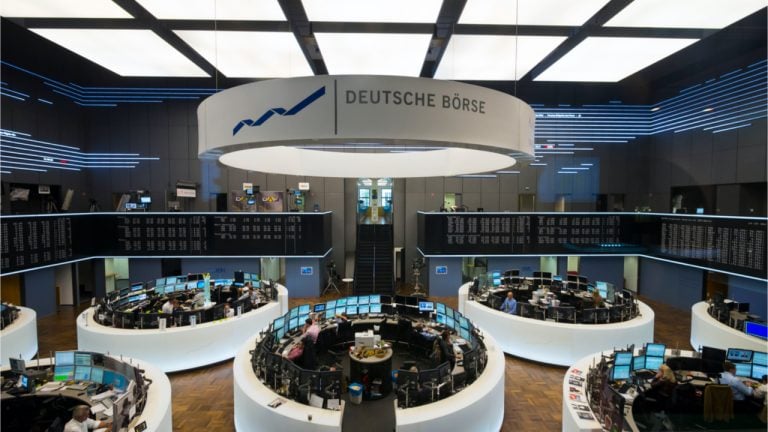
Asset management and exchange-traded fund (ETF) issuer VanEck has launched a new institutional product based on layer-1 blockchain Sui (SUI). In a press release, VanEck says it’s expanding its offerings with a new exchange-traded note (ETN) that allows investors to participate in the development of SUI without having to directly hold the token. The new […]
The post Investment Giant VanEck Issues New Sui ETN for European Markets As SUI Breaks New All-Time Highs appeared first on The Daily Hodl.

Avalanche price gained 16%+ in the last week, but are positive media headlines enough to sustain the AVAX rally?
After spending nearly six months in a downtrend, AVAX price looks to be in the early stages of a trend reversal. On Aug. 5, it traded at $17.29, its lowest price in nine months. Over the past two weeks, the altcoin has reversed course with a 45% gain to $25.25.
While AVAX’s flash crash under $18 was mirrored by most altcoins which also sharply sold off during Bitcoin’s (BTC) Aug. 18 correction to $49,500, AVAX has been a laggard versus the wider market since topping out at $65 on March. 18.
Positive news could be partially responsible for the recent uptick in the AVAX price. This week, AVAX investors zoomed in on the Avalanche token unlock schedule and noted that a sharp reduction in the number of token unlock events occurs after the end of 2024. Many investors believe that token unlocks generate sell pressure and deter the various types of long-term ecosystem development that support value accretion to the token.
 The United Kingdom’s Financial Conduct Authority has said it will not object to requests by recognised investment exchanges to launch crypto-backed exchange-traded notes. The exchange-traded notes will only be made available to professional investors such as regulated investment firms. ETNs Must Adhere to UK Listing Requirements The Financial Conduct Authority (FCA), the watchdog for the […]
The United Kingdom’s Financial Conduct Authority has said it will not object to requests by recognised investment exchanges to launch crypto-backed exchange-traded notes. The exchange-traded notes will only be made available to professional investors such as regulated investment firms. ETNs Must Adhere to UK Listing Requirements The Financial Conduct Authority (FCA), the watchdog for the […]
Financial regulators in the United Kingdom are allowing applications for crypto-based exchange-traded notes (ETNs), according to a new announcement. In a Monday press release, Britain’s Financial Conduct Authority (FCA) said that it has approved the sale of crypto and Bitcoin (BTC) ETNs for professional investors. ETNs in the UK are defined as bonds issued by […]
The post UK Regulators Greenlight Crypto-Based Exchange Traded Notes (ETNs) As Bitcoin Hits New All-Time High appeared first on The Daily Hodl.

Crypto investors still hope that the SEC will approve a spot-based BTC ETF one day, but data shows it has good reason not to.
It is not the first time the U.S. Securities and Exchange Commission (SEC) rejected proposals for a Bitcoin spot exchange-traded product (ETP), but efforts continue to be made by different financial institutions. The recent attempt made by Cboe BZX Exchange on Jan. 25 to list the Fidelity Wise Origin Bitcoin Trust as a Bitcoin ETP has also failed.
The SEC letter published on Feb. 8 pointed out that the exchange has not met its burden to demonstrate the fund is “designed to prevent fraudulent and manipulative acts” and “to protect investors and the public interest.”
Although proposals of Bitcoin spot ETPs have never been approved by the SEC and such products are not available in the U.S. market, they do exist in the European market. By investigating the prices of ETPs traded in the European market, one could gain a good insight into whether fraudulent and manipulative acts are possible.
To investigate whether the SEC’s concerns of fraudulent and manipulative acts are justifiable, this article will compare the historic prices of three European listed ETPs and the Bitcoin spot price history from 18 exchanges to see if there are any significant price disparities that could induce market manipulation.
There were two major concerns raised by the SEC from a technical perspective towards BZX Exchange’s proposal:
(1) No data or analysis was provided to support the argument that arbitrage across the Bitcoin platforms helps to keep global Bitcoin prices aligned with one another, thus hindering manipulation and eliminating any cross-market pricing differences. There is no indication of how closely Bitcoin prices are aligned across different Bitcoin trading venues or how quickly price disparities may be arbitraged away.
(2) The exchange does not demonstrate the proposed methodology for calculating the index would make the proposed ETP resistant to fraud or manipulation. Specifically, the exchange has not assessed the possible influence that spot platforms not included among the index’s constituent Bitcoin platforms would have on Bitcoin prices used to calculate the index.
To see if the above issues exist and whether manipulative acts are possible within the ETPs listed in the European markets, historic data (from Google Finance) of the following three ETPs listed in SIX Swiss Exchange are compared with Bitcoin spot price from exchanges (data from Cryptowatch).
As described in the proposal by BZX Exchange, the index calculation will be based on the volume-weighted median price (VWMP) in the previous five minutes from five exchanges — Bitstamp, Coinbase, Gemini, itBit, and Kraken.
In a very simple and basic attempt to replicate the index calculation with best efforts, the daily spot prices from four out of the five aforementioned exchanges — Bitstamp, Coinbase, Gemini and Kraken — are used.
Since the Bitcoin ETP price scale is often different from the Bitcoin spot price, the daily percentage change (or daily return) is used in all charts for easy comparison of price disparities.
The graphs below show the daily return comparison between each of the three ETPs and the aggregated Bitcoin spot price, calculated from the four exchanges using the volume-weighted median method.
The left-hand-side scatter plot shows how closely the ETP price is aligned to the spot price. If the two are perfectly aligned, all the points should fall onto the blue dash line. The right-hand-side plot compares the daily percentage return and also plots the difference between the two.
Comparing WisdomTree ETP and the spot, although most of the points in the scatter plot cluster within the +/-5% radius, there are certainly some significant price disparities outside this radius. One day during the three-month period had the daily return difference (blue dash line) between the ETP and spot price reached above 10%.

It is also interesting to note that the volatility of ETP price percentage change tends to be higher than the spot. The graph below comparing Coinbase Physical Bitcoin (blue line) and Bitcoin spot (pink line) shows the percentage change of the former could reach nearly 15% whereas the latter only went past 10%.

Similarly, 21Shares Bitcoin ETP price is also more volatile than the spot and the correlation with the spot is lower (62%) than that of WisdomTree (67%) and Coinbase Physical Bitcoin (66%).

The price comparisons shown above suggest cross-market pricing differences between the ETP price and the Bitcoin spot price from exchanges exist. The price disparities have not been arbitraged away quickly enough to prevent manipulative acts.
However, it is important to highlight that this is only a very rough comparison using the daily data. The difference in prices might be due to the different cut-off times each ETP uses to calculate the end-of-day price, i.e., exchange-traded products do not trade 24-hours like the crypto spot price; they trade during the Exchange’s regular trading hours from 9:30 am to 4:00 pm.
Also, in practice, a much higher frequency will be used to calculate the index price, i.e., the BZX Exchange proposal suggests calculating the index price using the previous five minutes data from five exchanges and updating the Intraday Indicative Value (IIV) per share every 15 seconds. The analysis done here is using only daily aggregated data to proxy the index price and might not reflect the actual index price using high-frequency data.
It is worth pointing out that although price disparities can be observed between ETPs and spot price using daily data, price discrepancies between the ETPs, themselves, are much smaller as shown in the graphs below.

It is very likely that these ETPs listed in the same exchange all use the same frequency and cut-off time to calculate their prices; hence, the price differences are smaller among themselves. This reinforces the point that the price disparities between the Bitcoin ETP and Bitcoin spot price might come from the frequency and the cut-off time used in the methodology of ETP index calculation, which can not be replicated exactly the same in this analysis.
In the first point of concern mentioned at the beginning of the article, the SEC also asked how closely Bitcoin prices are aligned across different Bitcoin trading venues.
Based on the cross-platform BTC/USD data collected from 18 exchanges from Cryptowatch, the exchange price disparities are very small. As an example to show how closely the prices align to each other, Coinbase, Gemini and Bitstamp are compared against Kraken and the correlation between each pair is very close to 100%.
The SEC is also concerned about the possibility of price influence and manipulation from spot platforms that are not included among the index’s constituents. If Bitcoin prices from other platforms are very different from the four constituent platforms, Bitstamp, Coinbase Gemini and Kraken market manipulators might seek to exploit the disparities for profit.
To see if price disparities exist between the four platforms and others, the bottom right graph below compares the aggregated volume-weighted median price from the four platforms with the aggregated price from all 18 exchanges. The nearly perfectly aligned line shows there is almost no difference between the two. The spot platforms do not have large price disparities and the prices are closely aligned across different Bitcoin trading venues.

With such great similarity in daily prices, manipulative acts will be very difficult across exchanges. However, price manipulation could still happen intraday but it’s beyond the reach of this analysis due to lack of high-frequency intraday data.
Based on the analysis from the three SIX Swiss Exchange listed ETPs prices and the Bitcoin spot prices from 18 exchanges, it seems price disparities do exist between ETP and spot. This could potentially lead to manipulative acts towards ETP index price, even though the applicants frequently claimed the sophisticated index calculation methodology prevents such acts.
The SEC’s concerns about fraud and manipulation seems to be justified based on the price disparities between these European listed ETPs and the spot price. That said, the difference could be caused by the daily data frequency used in this analysis, which is different from the high-frequency data used in practice.
On the contrary, no significant price disparities can be found among different Bitcoin trading venues. Although the spot markets from these venues are more decentralied and less regulated than traditional stock exchanges, malicious price manipulation across these platforms could still be very difficult.
Given the large number of centralized and decentralized, regulated and unregulated crypto exchanges out there, it is extremely hard to prove price efficiency and similarity across all of them. The U.S. ETP applicants still have a long way to go to convince the SEC.
The views and opinions expressed here are solely those of the author and do not necessarily reflect the views of Cointelegraph.com. Every investment and trading move involves risk, you should conduct your own research when making a decision.

The ETN will contain exposure to seven different major cryptocurrencies.
On Monday, VanEck, a financial institution with close to $82 billion in assets under management with exchange-traded funds, or ETFs, mutual funds and institutional accounts, announced the launch of its first cryptocurrency fund. The fund is listed as an exchange-traded note, or ETN, on the Deutsche Borse Xetra and SIX Swiss exchanges with exposure to Bitcoin (BTC), Ethereum (ETH), Polkadot (DOT), Solana (SOL), Tron (TRX), Avalanche (AVAX) and Polygon (MATIC).
Gijs Koning, co-head of VanEck Europe, elaborated on why it was important for the firm to facilitate investment in digital currencies:
"In early 2017, we determined that digital assets could provide a store of value alternative to currencies and gold, as well as a host of technology solutions that could bring down costs in the payments and investing industries."
While VanEck's cryptocurrency financial products are gaining traction in Europe, they face regulatory hurdles in the U.S. There, the firm's offerings are limited to private digital currency funds for institutional investors and only stock-based ETFs comprised of companies utilizing blockchain technology.
Last November, the U.S. Securities and Exchange Commission rejected VanEck's Bitcoin spot ETF application. In explaining the decision, the regulatory agency cited that the underlying exchange responsible for listing the ETF, Cboe BZX, did not have a proper "surveillance-sharing agreement with markets trading the underlying assets [of Bitcoin]." The SEC then used the same rule to reject Fidelity's Wise Origin Bitcoin Trust spot ETF the week prior. Two ETFs, the ProShares Bitcoin Strategy ETF and Valkyrie Bitcoin Strategy ETF, received SEC approval partly because they track the price of regulated Bitcoin futures contracts, and not its spot price derived from averages of numerous exchanges.

The number of crypto-based exchange-traded products in Europe continues to expand as 2022 draws nearer.
Nasdaq Stockholm has announced that 21Shares has listed their first two physically backed exchange-traded notes (ETNs) on the Swedish trading platform.
The two instruments listed, with Bitcoin (BTC) and Ether (ETH) as underlying assets, represent a new segment for ETNs — a type of unsecured debt security that tracks an underlying index of equities and trades on a major exchange.
According to the announcement, the new ETNs will provide investors access to investment opportunities in cryptocurrencies such as Bitcoin and Ether.
Helena Wedin, European head of exchange traded products at Nasdaq, says that exchange-traded notes allow one to invest in non-traditional assets while maintaining the transparency of a regulated market. She adds that "we are happy to launch this new segment at Nasdaq Stockholm with 21Shares as the first issuer.”
According to the press release, most traditional banks and brokers allow investors to trade all ETNs listed on Nasdaq Stockholm. This is a first which opens up new possibilities to investors interested in investing in cryptocurrencies, but who are not comfortable doing so on unregulated exchanges.
Related: ETN vs. ETF: Which Is the Investor’s Dream?
The cryptocurrency market has experienced a steep rise in valuation throughout the previous year. Despite some recent price dips, interest in cryptocurrencies continues to be high.
One reason for this sustained interest may be the possibility of increased institutional investment in the market. As institutional investment in cryptocurrencies increases, we'll likely see more products such as ETNs being listed on regulated exchanges. As reported by Cointelegraph in September, VanEck introduced Solana and Polkadot ETNs on Deutsche Boerse's Xetra.

Invesco’s spot Bitcoin ETN joins 25 other similar products on Deutsche Boerse’s digital exchange, Xetra.
Soon after dropping a filing for a Bitcoin (BTC) futures exchange-traded fund (ETF) in the United States, asset manager Invesco is launching a spot BTC exchange-traded note (ETN) in Europe.
On Nov. 29, German stock market operator Deutsche Boerse officially announced the listing of the Invesco Physical Bitcoin ETN on its digital stock exchange, Xetra. The new product will trade under the ticker symbol BTIC.
Admitted to the regulated market of the Frankfurt Stock Exchange, the new ETN product is physically backed by Bitcoin and is centrally cleared via Eurex Clearing. “Through central clearing, investors benefit from significantly reduced risks in the settlement of transactions,” the announcement notes.
According to a report by the ETF-focused publication ETF Stream, custody of Bitcoin held on behalf of BTIC will be provided by Standard Chartered’s crypto custody platform known as Zodia. Northern Trust, a co-investor in Zodia, will reportedly act as the administrator for BTIC. Launched in late 2020, Zodia is registered with the United Kingdom's Financial Conduct Authority.
Major European digital asset manager CoinShares is a known partner of Invesco and will serve as both the index sponsor and execution agent for the new ETN. BTIC is tracking the CoinShares Bitcoin Hourly Reference Rate index, delivering the price performance on the underlying asset minus fees.
The news comes shortly after Invesco withdrew its filing with the U.S. Securities and Exchange Commission for a Bitcoin futures-based ETF in October in order to provide investors with better investment options rather than just a 100% BTC futures ETF.
“Physical bitcoin is a more observable marketplace. One of our concerns was the depth of synthetic liquidity as well as what that may do to valuations over time and that is something we were not wholly comfortable with,” said Gary Buxton, head of ETFs and indexed strategies at Invesco. He added that Invesco has been working on the product “since the middle of 2018.”
Related: Deutsche Boerse launches Solana and Polkadot ETNs by VanEck
Invesco’s entrance to the European industry of crypto exchange-traded products (ETP) comes as Deutsche Boerse actively expands the range of supported crypto derivatives products across its operated exchanges. According to the firm, the Xetra exchange offers as many as 26 ETNs from seven providers on various cryptocurrencies including Bitcoin, Ether (ETH), Bitcoin Cash (BCH), Cardano (ADA), Litecoin (LTC), and others.
Both being a type of the ETP, ETFs and ETNs are fairly similar in that they both track an underlying asset and trading on exchanges in a similar manner to other securities. While an ETF presumes investment in a fund that holds the assets, an ETN is more like a bond, providing exposure to an unsecured debt note issued by an institution.
 On Tuesday, Deutsche Börse Group, marketplace manager for the trading of shares and other securities, explained the company has acquired a major stake in Crypto Finance AG. The move adds to Deutsche Börse’s extension into the cryptocurrency industry in order to provide custody solutions and a “direct entry point for investments.” Deutsche Börse Group to […]
On Tuesday, Deutsche Börse Group, marketplace manager for the trading of shares and other securities, explained the company has acquired a major stake in Crypto Finance AG. The move adds to Deutsche Börse’s extension into the cryptocurrency industry in order to provide custody solutions and a “direct entry point for investments.” Deutsche Börse Group to […]